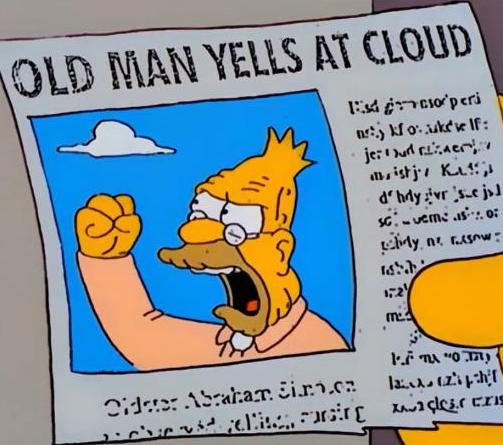Introduction
Social media (and social media video) has absolutely grown the market for video professionals, but it’s not all good. For every perfectly useful customer profile that we now deliver through YouTube (not really social media) there are a thousand TikToks and Facebook videos clamoring for our audience’s attention.
Video has never been more popular, but it’s never had less in common with professional video. It’s all amateur, all the time, and it’s a problem for us, for viewers, and (I don’t think I’m overstating this) for the future of our society. Here, I’m going to release my inner Abe Simpson and rant at some clouds.
Jump cuts due to poor planning
You know, as a professional, how to make a video about something. You write and refine a script which hits all the important points, and record a voiceover. Maybe you record an introduction and a conclusion as a piece to camera, and you’ll certainly need b-roll to illustrate whatever the script is talking about. With all those assets in hand, you can combine them to create a smooth, effective edit.

But that’s not what happens on social media. Instead, someone holds a phone in one hand, the object in the other, and records their stream of consciousness as they experience the object for the first time. Then they just jump cut out the pauses and anything else that doesn’t make sense. (Scott Simmons dissected one of these recently, right here.)
This isn’t just lazy, it’s a waste of the audience’s time. It’s not the jump cuts I hate, per se, it’s the utter lack of preparation. Just shoot some more B-roll, and use it? If you can do it in iMovie on an iPhone, but you’re not, there’s no excuse.
Distraction is not information
If you want to make a video about dancing, go for it. If you want to make a video on a serious topic, go for it. But why make a video about a serious topic that’s illustrated with you dancing in the background? The actual factual content has already been reduced to half a tweet’s worth, and now you’re training everyone to only pay attention to something important if there’s also colour and movement to distract you?
Insert screaming here, with dancing behind.
It’s quantity over quality
While you can deliver videos of reasonable duration on most social platforms these days, the very short duration of those videos means that most users now just swipe to the next clip in the never-ending firehose at the first hint of anything remotely difficult or challenging.
If YouTube is a decent meal, and a video on Facebook is a fast food meal, a TikTok is like a single french fry. It’s not valued, in and of itself, and if you make something for TikTok, know that it’s mostly for them and not for you.
Social media isn’t social anymore
When Facebook kicked off, it was about connecting with your friends, and that’s what you saw. Same with Instagram — you chose to follow people who posted interesting content, and people followed you if you did the same. But that’s not how things work today. On most social platforms, you don’t just see posts from people you follow, but also many more ads (unsurprisingly) and trending topics. The main game on TikTok is to get to the “For You” page, which is actually “For Everyone”.
Social media started out as something new, empowering individual creators and creating a way to share cheesy videos with one another, but today it’s just another distribution pipeline.
Algorithms are optimizing for engagement, not users
The original promise of social media was alluring. For a new creator, the studio or network gatekeepers were the ones keeping you from telling your stories, and social media allowed you, an outsider, to build your own audience.
Instead, social media networks have become, alas, just a new kind of gatekeeper. Instead of having to please a person in a position of power, you now have to please an algorithm, and that algorithm pushes content largely based on how much it engages people, not on how much it informs, or entertains, or breaks new ground, or how good it is. The algorithm is why more people than ever believe blatant falsehoods to be fact; they’ve been spoon-fed videos just like the last videos they’ve watched.
Besides the growth of conspiracy theories, this messes with people’s sense of normality, because suddenly everything you see confirms everything you just saw. It’s a polarization amplifier, and simply couldn’t happen without algorithms ready to show you a video on every crazy niche. It turns out that those human gatekeepers had value after all.
It’s all so bad, there’s no point doing it well
If we’re honest, we’ve all made some bad videos in our past. Everyone has to start somewhere, and our first edits weren’t masterpieces. But we got better, and now we know how to create good videos. On YouTube, good content is key to building a following, and that’s probably how it should be.
But that doesn’t really count on social media — you can put out any old garbage, because the standard is set so low. A single shot of you syncing to a music track? Sure. Someone fell over and you were there? Congratulations. You didn’t bring a microphone? No problem. Mistakes are authentic. Don’t try too hard or people won’t believe you’re real.
It’s destroying your children’s brains
Seriously, don’t let your kids ingest a non-stop firehose of this nonsense. While I’m sure most older people watched plenty of TV growing up, at least those shows largely had stories, or tension, or competition — something worth watching. The kinds of shows we’d all prefer to be working on.
But if the average video is ten seconds long, it’s not going to have any more lasting value than a clip of someone on Funniest Home Videos, and plenty of kids spend a lot more time on social media than they do watching TV or movies. Everything’s easy, bite size, no effort, no need to think. I said a TikTok was like a french fry earlier, but I think it’s closer to a french fry that’s been mashed down and turned into a tiny spoon of addictive, caffeinated baby food. Kids need a better mental diet than that.
It’s ruining body image and destroying happiness
Social media shows the absolute highlights of everyone’s days, the results hours of primping and preparation, with lighting before and retouching and filters afterwards. When you ingest a diet of nothing but beautiful highlights from beautiful people doing beautiful things, you’ll subconsciously become disappointed that you don’t look like them, and you’re not visiting beautiful places like they are.
To be fair, this isn’t new, and it’s not just about video. This was true when Instagram was just still images, and it’s not improved now that Instagram is mostly about short vertical videos instead. But it’s still a massive problem, and not just for teenagers.
Vertical video is selfish
I get that most people want to hold their phones vertically, and I get that social media is all about making content easier for the user to consume (that sentence made me throw up a little) but the fact remains: portrait video is a lousy format for showing more than one person at a time — it’s just too narrow.
Landscape shots are great for groups, or, you know, landscapes, and it’s very hard to craft a story when you can’t see more than one person’s face properly. There was a short-lived streaming company, Quibi, which tried to make all its productions work in both aspect ratios, but it failed spectacularly. Mind you, I think it’s probably because people expect good content to be in landscape, and cheap social content to be seen vertically. Professional = landscape, amateur = vertical. More obvious than high frame rates feeling “cheap”, but along the same lines.
Now that’s not to say that you shouldn’t make vertical videos — if you’re making ads that target vertical platforms, you’ve got to play by their rules, and ads can creatively use the space without having to craft a longer story. You get to explore something new while raising the bar just a little. But for the most part, serious content remains firmly fixed (thank goodness) in landscape.
Looping is evil
Some reels can be fine — a quick timelapse, a simple idea expressed well. But all too often, then they ruin it by starting again from the beginning, with the same annoying part of the same annoying track, and it makes me want to scream.
Every TikTok does it, and while the kids might be cool with a short idea repeating over and over, I just want to quit the app and destroy the servers from orbit, because it’s the only way to be sure.
Conclusion
Sure, I’m bitter, but this isn’t a new thing. It was over a decade ago that I entered a travel video contest with a well-edited look back at some of my trips overseas, only to be beaten by an unedited video of a sheep scratching itself on a fence. (This really happened.)
The bar has been well and truly lowered, and although that’s not great, we can take solace in the fact that there’s never been more good content available. Video has exploded, and we got more good stuff as well as (a lot) more bad stuff. At the end of the day, all we can do is keep making good things, and showing clients why they should care about quality.
For now at least, “social” media and “real” media video do occupy separate spaces. Long may that continue, because although we’re all getting older, I’m sure we don’t need to be reminded quite as often as we are.
(All images from the ever-handy pexels.com.)


